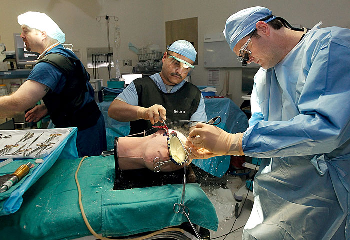 Imagine you have a brain tumor and your doctor says surgery is the only way to save your life. Now also imagine that the doctors have a 3-D image of your brain and get to “practice” the surgery before the actual procedure.
Imagine you have a brain tumor and your doctor says surgery is the only way to save your life. Now also imagine that the doctors have a 3-D image of your brain and get to “practice” the surgery before the actual procedure.
That may be what the future holds. At the University of Texas Medical Branch at Galveston, doctors in training to become neurosurgeons are using 3-D imaging mixed with a dose of virtual reality to identify diseased portions of the brain and to perform surgery.
The unique 3-D set up sits discreetly in a lab in UTMB’s John Sealy Hospital and is one of about 10 in the nation and the only one in Texas.
Yanking neurosurgical training out of the caves and into the 21st century has been Dr. Jaime Gasco’s mission ever since he became director of neurosurgery resident education for UTMB in late 2011.
“What we have going on now is not happening anywhere else in the country,” Gasco says. “Right now, everybody should be doing this.”
Once in the lab, Gasco leans forward, his attention fixed on the task in front of him. Above, on a large computer monitor, there’s a 3-D image of the top of a human head, and there’s the whine of a drill as he approaches his goal. Using essentially a very fancy joystick, he can closely mimic the sensation of boring through bone and brain.
“When I get to the ventricle I should feel a pop, as I enter this fluid-filled cavity,” he says. “There — I felt it. And it’s giving me a score of 13.7, which is a pretty good score.” Gasco leans back from the white arcade-game style cabinet where he has been working and removes his 3-D goggles.
“I learned to do surgery in the traditional way, which compared to this is sort of the caveman way of learning it,” Gasco says. “It looks like an easy thing to do, but you have to do a lot of these procedures before you get really good. And with this and our other simulators, our students can do that without ever touching a real patient.”
The lab also uses remarkably lifelike physical simulators, including heads that contain texturally accurate brains and faithful representations of tumors and blood vessels that bleed simulated blood.
“Physical simulators are good because you’re actually using the same instruments as in the operating room, so you build the same eye-hand coordination skills,” Gasco says. He holds up a mannequin’s head. “We have mannequins where you can insert real endoscopes through the head and see tumors and fake blood vessels on camera — pretty amazing and remarkable things.”
Gasco and the residents recently took the simulations to a new level when they performed procedures on the physical mannequins in one of the operating rooms at John Sealy Hospital.
According to Gasco, his students appreciate the chance to work with such cutting-edge tools — although, never having had to learn the “caveman way” they probably don’t know how good they have it. It doesn’t bother him, though. “In an academic institution, we have an obligation to make our residents better than we are,” he says. “That’s why I’m doing this.”
Photo by Jennifer Reynolds, Galveston County Daily News.